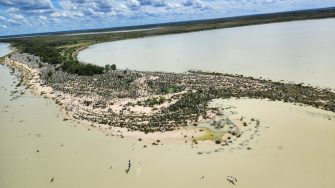
Date: Tuesday November 8th 2022
Project: Eastern Australian Waterbird Survey
Observers: John Porter & Shannon Dundas
Pilot: Alex Katopodis
Once again bad weather seems to have followed us and we wake to steady rain. Thankfully the showers are localised and we are able to depart after only a short delay.
Preparing for survey in the rain at Moree aerodrome.
We depart Moree and head west to complete counts on the Gwydir before flying to Narran Lake, west of Lightning Ridge.
Surveying along the Gingham watercourse.
Surveying along the Gingham watercourse.
The Narran River has brought plenty of flood water into the wetlands of Narran Lake Nature Reserve and also flooded the extensive floodplains of lignum and river coobah to the south before filling Narran Lake itself. There are a huge expanses of water across the landscape. Most of the wetlands have low numbers of waterbirds, Straw-necked Ibis, Great and Pied Cormorants, spoonbills, herons and egrets with occasional Black Duck, Wood Duck and Grey Teal.
Narran Lake.
Narran Lake.
Narran Lake.
Surveying Narran Lake Pelican colony.
Back Lake on the Nature Reserve has a colony of around 2-3,000 Straw-necked and White Ibis nesting, and Clear Lake has a colony of several hundred Pied and Great Cormorants breeding. Narran Lake has two large (3-5,000 nests) Pelican colonies established, which is a sign of just how much fish and other food resources must be available at the moment.
Flooded lignum of Back Lake in Narran Lake Nature Reserve.
After refueling at Bourke we head to Yantabulla followed by Lakes Wyara and Numalla located in Currawinya Lakes National Park in Queensland. Yantabulla is only about 30 percent full and has very low numbers of waterbirds, but alarmingly high numbers of feral pig.
Surveying over Yantabulla wetlands.
Surveying over Yantabulla wetlands.
Surprisingly, the Currawinya lakes are drying back, and are currently only around two thirds of their maximum extent when fully flooded. As expected, relatively few waterbirds are on the freshwater Lake Numalla with the exception of a huge pelican colony with around 7-8,000 pelicans nesting, a spectacular site! They are located on a sandy peninsula that juts into the lake, a location we have recorded pelicans breeding in previous years. Last year pelicans nested on an island in the adjacent saline lake, Lake Wyara. This year Lake Wyara has moderate numbers of waterbirds, including hundreds of Grey Teal. Also present are Hardhead and Pink-eared Ducks, together with Black Swans and Eurasian Coot.
Pelicans nesting on Lake Numalla in Currawinya National Park.
Pelicans nesting on Lake Numalla in Currawinya National Park.
Pelicans nesting on Lake Numalla in Currawinya National Park.
After completing our counts on Currawinya we head back to Bourke to stay overnight.

